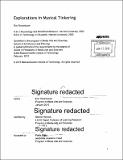| dc.contributor.advisor | Mitchel Resnick. | en_US |
| dc.contributor.author | Rosenbaum, Eric (Eric Ross) | en_US |
| dc.contributor.other | Massachusetts Institute of Technology. Department of Architecture. Program in Media Arts and Sciences. | en_US |
| dc.date.accessioned | 2015-07-31T19:09:21Z | |
| dc.date.available | 2015-07-31T19:09:21Z | |
| dc.date.copyright | 2015 | en_US |
| dc.date.issued | 2015 | en_US |
| dc.identifier.uri | http://hdl.handle.net/1721.1/97970 | |
| dc.description | Thesis: Ph. D., Massachusetts Institute of Technology, School of Architecture and Planning, Program in Media Arts and Sciences, 2015. | en_US |
| dc.description | Cataloged from PDF version of thesis. | en_US |
| dc.description | Includes bibliographical references (pages 171-174). | en_US |
| dc.description.abstract | This thesis introduces the idea of "musical tinkering," exploring how to engage people in playfully creating and experimenting with their own musical instruments and compositions. I discuss the design and study of two new tools for musical tinkering, MelodyMorph and MaKey MaKey. MelodyMorph is an iPad app for making musical compositions on the screen. MaKey MaKey is an invention kit that lets you transform everyday objects into physical-digital musical instruments. Two themes of musical tinkering, the loop and the map, are woven throughout this thesis. Loops are feedback processes. They range in scope from rapid iterative design, through interpersonal interaction and creative emergence, to longer-term personal transformation. Maps are active visualizations. We use them to externalize our thought processes, and we fluidly manipulate them as we tinker, linking graphical or tangible symbols to musical sounds. I use loops and maps as the basis for design concepts for musical tinkering tools and to analyze musical tinkering as a learning process. I present case studies of middle school students tinkering as they use MelodyMorph to compose musical stories, reconstruct tunes from video games, and make musical cartoons. I also present case studies of MaKey MaKey, showing how people have used it to tinker with music "in the wild," in my own workshops, and in the work of other educators. Through these case studies I characterize musical tinkering using the concepts of musical landscape-making, musical backtalk, and musical inquiry. I show that loops and maps intertwine in the processes of collaborative emergence, inventing new maps for new instruments, and tinkering with musical ideas and musical attitudes. Finally, I conclude with visions for remaking the landscape of musical tinkering in the future. | en_US |
| dc.description.statementofresponsibility | by Eric Rosenbaum. | en_US |
| dc.format.extent | 174 pages | en_US |
| dc.language.iso | eng | en_US |
| dc.publisher | Massachusetts Institute of Technology | en_US |
| dc.rights | M.I.T. theses are protected by copyright. They may be viewed from this source for any purpose, but reproduction or distribution in any format is prohibited without written permission. See provided URL for inquiries about permission. | en_US |
| dc.rights.uri | http://dspace.mit.edu/handle/1721.1/7582 | en_US |
| dc.subject | Architecture. Program in Media Arts and Sciences. | en_US |
| dc.title | Explorations in musical tinkering | en_US |
| dc.type | Thesis | en_US |
| dc.description.degree | Ph. D. | en_US |
| dc.contributor.department | Program in Media Arts and Sciences (Massachusetts Institute of Technology) | |
| dc.identifier.oclc | 913962903 | en_US |
